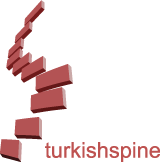ABSTRACT
Objective
To evaluate the effectiveness of transforaminal epidural steroid injection (TFESI) in patients with failed back surgery syndrome (FBSS) after unilateral biportal endoscopic (UBE) lumbar discectomy.
Materials and Methods
Between 2022 and 2024, 14 patients who underwent single-level UBE discectomy and continued to suffer from radicular pain were included. Patients without motor deficit or obvious recurrent/residual disc herniation were treated with TFESI. Pain relief was evaluated using the visual analog scale (VAS) and the MacNab criteria.
Results
Mean pre-procedure VAS score for leg pain was 6.14±1.35, which significantly decreased to 2.64±1.75 at the 6th week follow-up (p<0.0001). According to the MacNab criteria, 78.4% of patients reported “good” or “excellent” outcomes.
Conclusion
Transforaminal epidural injection appears to be a safe and effective option in managing FBSS after UBE. More comprehensive prospective randomized studies need to be conducted.
INTRODUCTION
Lumbar disc herniation (LDH) is frequently seen in our society due to reasons such as obesity related to poor nutrition, lack of regular exercise habits, and working in heavy labor. Although most LDH cases improve with conservative treatments, surgical options are necessary in cases of progressive motor deficit and prolonged pain where conservative treatments are insufficient. However, it is known that in 10-40% of patients who undergo surgery, back pain or radicular pain does not completely resolve(1–3). This condition is defined in the literature as failed back surgery syndrome (FBSS)(1). The exact cause of FBSS has not been established in cases where the surgical technique is assumed to be correct. Controversial indications, postoperative scar tissue, reherniation/residual disc, or iatrogenic instability can be counted among the causes(4, 5). Although FBSS can be treated with medication, injection (transforaminal or caudal), or reoperation, there is no standard. This study examined the effectiveness of transforaminal epidural steroid injection (TFESI), a low-risk minimally invasive treatment method, in cases of FBSS following unilateral biportal endoscopic discectomy (UBE). To our knowledge, this is the first study in the literature to investigate the effectiveness of transforaminal injection in FBSS following UBE.
MATERIALS AND METHODS
We retrospectively examined patients with FBSS who had undergone UBE single-level discectomy between 2022 and 2024 and were followed up for at least one year. Patients with persistent symptoms causing motor deficits and with evidence of recurrent or residual disc herniation on lumbar magnetic resonance imaging (MRI) underwent reoperation. TFESI was performed in patients without motor deficits whose complaints had improved but who continued to experience radicular pain and numbness, and in whom imaging revealed no obvious recurrent discopathy (Figure 1A-D).
All procedures were performed by a single surgeon with 5 years of UBE experience. TFESI was performed in the operating room under local anesthesia with C-arm fluoroscopic guidance. Using a 22-gauge spinal needle, anteroposterior and lateral imaging was obtained.
After confirming the periradicular placement with contrast injection, a mixture of 40 mg methylprednisolone and 1 cc bupivacaine was administered (Figure 1E-F). Patients without complications (e.g., anaphylaxis, foot drop) were discharged two hours after the procedure.
Inclusion criteria were:
1. age between 18-65 years;
2. having initially achieved satisfactory recovery after single-level lumbar discectomy using the UBE technique, but later developing recurrent clinical symptoms within 6 months postoperatively, with MRI findings consistent with epidural fibrosis;
3. having had back and leg pain for at least 6 months;
4. not responding to conservative treatments.
Exclusion criteria were:
• previous microsurgical surgery;
• multilevel epidural fibrosis;
• prior surgery for multilevel disc herniation;
• prior lumbar fusion surgery;
• history of TFESI prior to UBE surgery;
• recurrent disc herniation on multiple occasions;
• sacroiliac or facet joint pain;
• lumbar spinal stenosis, spondylolysis, spondylolisthesis, or scoliosis.
Clinical outcomes were evaluated using the visual analog scale (VAS) and the modified Macnab criteria. Pre- and post-procedure VAS scores (at 6 weeks) were compared.
This study was approved by the Ethics Committee of University of Health Sciences Türkiye, Sincan Training and Research Hospital (decision no: BAEK-2025-48, date: 22.07.2025). Written informed consent was obtained from all participants.
Statistical Analysis
Statistical analysis was performed using SPSS for Windows version 24.0 software (IBM Corp) Descriptive data were expressed as mean ± standard deviation, median (interquartile range 25th-75th) or number (frequency), where applicable. The normality of the distribution of continuous variables was tested using the Shapiro-Wilk test. The Mann-Whitney U test or Student’s t-test was performed to compare quantitative variables.
RESULTS
In our institution, 14 of the 124 patients operated on using the UBE method (11.2%) experienced recurrence of pain immediately after the procedure or after a certain period of time, or residual pain affecting their daily lives. Since none of these patients had neurological deficits, revision surgery was not initially planned. TFESI was performed on the affected root.
The study population consisted of 14 patients (8 female and 6 male) with a mean age of 47 years (range, 22-63 years). The most commonly operated level was L4-L5 (n=9), followed by L5-S1 (n=5).
The preoperative leg pain VAS score of the patients was 6.14±1.35 (4-8), while the post-operative leg pain VAS score at the one-and-a-half-month outpatient follow-up was found to be 2.64±1.75(1-8) (Table 1). This decrease was found to be statistically significant (p<0.0001).
The patients’ satisfaction levels after the injection were measured using the MacNab criteria. Two patients (14.3%) were rated as excellent, 9 patients (64.3%) as good, 1 patient (7.1%) as fair, and 2 patients (14.3%) as poor (Figure 2). Revision surgery was required in 2 patients whose pain seriously affected their quality of life and who did not experience the expected benefit from the procedure.
DISCUSSION
In the present study, we evaluated the outcomes of TFESI in patients with FBSS following UBE. Our results demonstrated that, although TFESI was not effective in every single case, it provided significant pain relief and functional improvement in the majority of patients. These findings suggest that TFESI can be considered a useful and minimally invasive treatment option for managing persistent symptoms after UBE surgery.
Post-spinal surgery epidural fibrosis is excessive scar tissue formation secondary to the overproduction of fibrotic tissue replacing epidural fat tissue(5, 6). It can lead to central canal stenosis, nerve root irritation, and even epidural blockage. Periradicular scar tissue can reduce perfusion and lead to decreased venous return. Stenosis and circulatory impairment in the region result in inflammation and edema of the nerve root(7). Since revision surgeries aimed at excising the scar tissue causing this neural damage are challenging and have high complication rates, minimally invasive procedures such as transforaminal injection may be considered for pain control in the management of such patients. This study evaluated the effectiveness of the transforaminal injection method in patients with FBSS who underwent endoscopic surgery. According to the results of the study, patients showed statistically significant improvement at their 6-week follow-up after TFESI.
The success rate of selective transforaminal nerve root block in unoperated cases has been reported to range from 18% to 90%(8). TFESI is highly effective in the short term (6 weeks) and moderately effective in the long term for lumbar radicular pain, but its effects are limited in radicular pain in FBSS cases(9-11). Devulder(12) found TFESI to be ineffective in FBSS. In their study, Mavrocordatos and Cahana(13) determined that TFESI was moderately effective in the treatment of failed back surgery. Celenlioglu et al. (5) reported that in 30 patient series, pain decreased by more than 50% in 60% of patients on the 21st day after TFESI. At 3 months post-procedure, the same level of comfort was maintained in 26% of patients(5).
Although different results have been reported in the literature, scar tissue development may be reduced in UBE because it is possible to preserve the epineural adipose tissue and less laminectomy/laminoplasty is performed. We predict that when the scar tissue density in the perineural tissue is low, the results of transforaminal injection may be as successful as procedures performed on non-operated patients. As scar tissue density decreases, the injection content administered to the area may achieve better penetration into perineural tissues. In summary, we achieved positive results in 78.4% of patients in our study. We achieved success rates close to those reported in the literature for TFESI procedures performed on non-operated patients. We believe these results may be an advantage of UBE, which is a minimally invasive approach.
Proper patient selection plays a critical role in achieving high success rates. Even with the UBE method, extensive scar tissue development is possible because each patient’s response to surgery may differ. MRI can be used to suggest alternative treatment methods for such patients. On the other hand, using a 0-degree telescope during the UBE procedure may increase bone/ligamentum flavum excision, which could increase scar tissue formation. If the surgeon can perform the operation with minimal tissue damage using an angled (30-degree) telescope, it may also increase the success of minimally invasive injections that may be required.
Study Limitations
However, the study has some limitations. The main limitations are the small sample size, short follow-up period, non-repetition of injections, and the absence of a control group. The strongest aspect of this study is that it is, to our knowledge, the first study to investigate the efficacy of TFESI in patients with FBSS operated on using the UBE method and contributes to the knowledge base in the literature on this subject.
CONCLUSION
TFESI is a safe method for treating FBSS caused by epidural fibrosis following lumbar discectomy with UBE. Although the effectiveness of the method in cases following microsurgery is controversial in the literature, we believe that better results are possible in cases of FBSS following UBE. This method may increase comfort and shorten disability periods. Larger, long-term, prospective, randomized controlled studies are needed to better understand these methods are needed to better evaluate this method in the treatment of FBSS.



